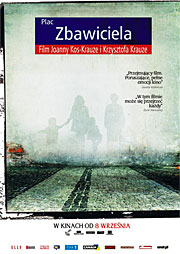 Saviour’s Square
Saviour’s Square
Plac Zbawiciela
2006, colour, 105 mins
- Directors: Joanna Kos-Krauze, Krzysztof Krauze
- Producer: Juliusz Machulski
- Script: Joanna Kos-Krauze, Krzysztof Krauze, with additional dialogue by Arkadiusz Janiczek, Jowita Miondlikowska, Ewa Wencel
- Camera: Wojciech Staroń
- Editing: Krzysztof Szpetmański
- Production Design: Monika Sajko-Gradowska
- Costume Design: Dorota Roqueplo
- Cast: Jowita Budnik (Beata); Arkadiusz Janiczek (Bartek); Ewa Wencel (Teresa); Dawid Gudejko (Dawid); Natan Gudejko (Adrian); Beata Fudalej (Edyta); Małgorzata Rudzka (Ola); Zina Kerste (Hania)
The latest film by Krzysztof Krauze (this time sharing writing and directing credits with his wife Joanna Kos) returns to the territory of his breakthrough The Debt in its chilling portrait of how external economic forces can devastate the lives of ordinary people – though here there are no gangsters or melodramatic threats, merely the day-to-day problems of people whose life is unexpectedly turned upside down by a single event.
Bartek (Arkadiusz Janiczek) and Beata (Jowita Budnik) have just sold their flat and have temporarily moved in with Bartek’s mother Teresa (along with their young sons David and Adrian) prior to starting a new life in a much more child-friendly area. But the company developing their new flat goes bankrupt, wiping out their savings, and if things weren’t already tense due to the fact that Teresa (Ewa Wencel) has also lost a substantial sum in the disaster, they’re exacerbated by the fact that she’s never got on with her daughter-in-law and they find life together quite unbearable. And that’s before Beata discovers Bartek’s secret…
With the aid of flawless performances, Kos and Krauze deftly sketch the family’s newly pressurised lives, as well as offering vivid glimpses of life in contemporary Poland. The three leading actors are also credited as co-writers, resulting from the directors’ decision to develop the script through improvisation workshops in a fashion inspired by Mike Leigh, and those familiar with Leigh’s own dysfunctional families, especially in Meantime (1984) and Life is Sweet (1990), will find much to recognise here. Kos and Krauze are highly sensitive towards their characters’ social class: Beata comes from a rural background where everyone looks out for each other, and is helplessly out of her depth when it comes to the pressures of city life.
Her eventual breakdown is foreshadowed by the film’s opening sequence, which jumps forward in time to hint at a dreadful tragedy but offers few concrete details. The Debt did something similar, and it’s a technique that deliberately casts a pall over the entire film, tainting even the early scenes of wide-eyed optimism about the future. The title comes from the address of Teresa’s flat, the square dominated by a statue of Christ. His hands are presumably conferring spiritual benediction on those that live there, but that turns out to be scant comfort in this aggressively secular age.
Links
- Official website (in Polish and English)
- IMDB entry
- Variety review (Eddie Cockrell)
- Culture.pl’s entry on Krzysztof Krauze (in English) was published before Saviour’s Square was made, but provides valuable contextual material.